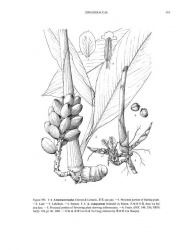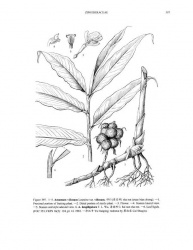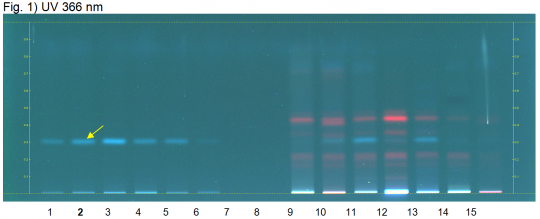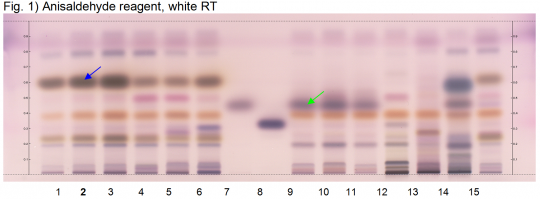Amomum spp. (fruit)
| Line 3: | Line 3: | ||
=Botanical Voucher Specimen= | =Botanical Voucher Specimen= | ||
| − | {{Media2 |cat= | + | |
| + | |||
| + | =Organoleptic Characteristics= | ||
| + | |||
| + | =Macroscopic Characteristics= | ||
| + | {{Media2 |cat=Macroscopic |companyimage=TropicosLogo.gif | ||
| companyURL=http://www.tropicos.org/Image/43058 | | companyURL=http://www.tropicos.org/Image/43058 | ||
|companyimage2=TropicosLogo.gif | |companyimage2=TropicosLogo.gif | ||
| Line 11: | Line 16: | ||
|image2=Amomum longiligulare Tropicos 36258.jpg | |image2=Amomum longiligulare Tropicos 36258.jpg | ||
|source2=Tropicos.org. Missouri Botanical Garden. 06 Aug 2013 <http://www.tropicos.org/Image/36258>}} | |source2=Tropicos.org. Missouri Botanical Garden. 06 Aug 2013 <http://www.tropicos.org/Image/36258>}} | ||
| − | |||
| − | |||
| − | |||
| − | |||
| − | |||
=Microscopic Characteristics= | =Microscopic Characteristics= | ||
Revision as of 19:02, 16 March 2014
Contents |
Nomenclature
Botanical Voucher Specimen
Organoleptic Characteristics
Macroscopic Characteristics
|
|
|
[[Category:Tropicos.org. Missouri Botanical Garden. 06 Aug 2013 <http://www.tropicos.org/Image/43058>]]
[[Category:Tropicos.org. Missouri Botanical Garden. 06 Aug 2013 <http://www.tropicos.org/Image/36258>]]
Microscopic Characteristics
High Performance Thin Layer Chromatographic Identification
|
Round cardamom fruit, dou kou (fruit) (Amomum krervanh, Amomum compactum) Lane Assignments Lanes, from left to right (Track, Volume, Sample):
Reference Sample(s) Reference: Dissolve 10 µL of cineole in 1 mL of methanol; Dissolve 10 µL of linalool in 1 mL of methanol. Stationary Phase Stationary phase, i.e. Silica gel 60, F254 Mobile Phase Toluene, ethyl acetate 93:7 (v/v) Sample Preparation Method Sample: Mix 500 mg of powdered sample with 5 mL of toluene, xylene 1:1 (v/v) and sonicate for 10 minutes, then centrifuge or filter the solutions and use the supernatants / filtrates as test solutions. Derivatization reagent: Anisaldehyde reagent, Preparation: 170 mL of ice cooled methanol is mixed with 20 mL acetic acid, 10 mL of sulfuric acid and 1 mL of anisaldehyde, Use: Dip (time 0, speed 5), heat at 100°C for 3 min. Detection Method Saturated chamber; developing distance 70 mm from lower edge; relative humidity 33% Other Notes Images presented in this entry are examples and are not intended to be used as basis for setting specifications for quality control purposes. System suitability test: Cineole: violet zone at Rf ~ 0.47 (white RT); Linalool: violet zone at Rf ~ 0.35 (white RT). Identification: Compare result with reference images. The fingerprint of the test solution is similar to that of the corresponding botanical reference sample. Additional weak zones may be present. Prior to derivatization under UV 366 nm the chromatogram of the test solution shows one distinct fluorescent zone at Rf ~ 0.30 (yellow arrow). After derivatization under white RT the chromatogram of the test solution shows a violet zone at Rf ~ 0.47 corresponding to reference substance cineole, and an orange zone just below it (green arrows). There is a violet zone at Rf ~0.21 and another violet zone right above the application position. Test for other species: No zone is seen at Rf ~ 0.60 (Round cardamom fruit, blue arrow). ). The other species show distinctively different fingerprints (see chromatogram). Source: HPTLC Association [3] |
|
Villous amomum fruit, Sha ren (fruit) (Amomum villosum, Amomum longiligulare) Lane Assignments Lanes, from left to right (Track, Volume, Sample):
Reference Sample(s) Reference: Dissolve 10 µL of cineole in 1 mL of methanol. Dissolve 10 µL of linalool in 1 mL of methanol. Stationary Phase Stationary phase, i.e. Silica gel 60, F254 Mobile Phase Toluene, ethyl acetate 93:7 (v/v) Sample Preparation Method Sample: Mix 500 mg of powdered sample with 5 mL of toluene, xylene 1:1 (v/v) and sonicate for 10 minutes, then centrifuge or filter the solutions and use the supernatants / filtrates as test solutions. Derivatization reagent: Anisaldehyde reagent, Preparation: 170 mL of ice cooled methanol is mixed with 20 mL acetic acid, 10 mL of sulfuric acid and 1 mL of anisaldehyde, Use: Dip (time 0, speed 5), heat at 100°C for 3 min. Detection Method Saturated chamber; developing distance 70 mm from lower edge; relative humidity 33% Other Notes Images presented in this entry are examples and are not intended to be used as basis for setting specifications for quality control purposes. System suitability test: Cineole: violet zone at Rf ~ 0.47, Linalool: violet zone at Rf ~ 0.35. Identification: Compare result with reference images. The fingerprint of the test solution is similar to that of the corresponding botanical reference sample. Additional weak zones may be present. The chromatogram of the test solution shows a violet zone below the solvent front. Below it there is an intense brown zone at Rf ~ 0.60 (blue arrow). Right above the position of reference cineole there may be a pink zone. Below cineole there is an orange zone at Rf ~ 0.38. There is a brown zone at Rf ~ 0.24 and just below it a blue zone. A violet zone is seen right above the application position. Test for other species: No zone is seen at the position of cineole (Round cardamom fruit, green arrow). The other species show distinctively different fingerprints (see chromatogram).
|
Supplementary Information
Sources
- ↑ Tropicos.org. Missouri Botanical Garden. 06 Aug 2013 <http://www.tropicos.org/Image/43058> http://www.tropicos.org/Image/43058
- ↑ Tropicos.org. Missouri Botanical Garden. 06 Aug 2013 <http://www.tropicos.org/Image/36258> http://www.tropicos.org/Image/36258
- ↑ HPTLC Association http://www.hptlc-association.org/
- ↑ HPTLC Association http://www.hptlc-association.org/



